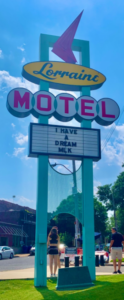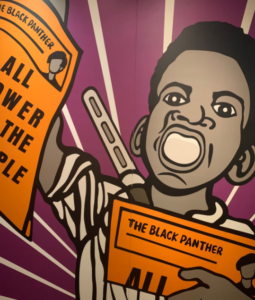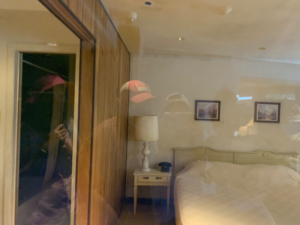



by Leeya
Welcome to the Civil Rights Museum, formerly the Lorraine Motel. The vibrant colors of the sign that read “Lorraine Motel” greeted us. My brother exclaims “Look! That sign looks like the one from the play.” A few months back, we had watched Mountaintop, a play about Martin Luther King’s last night alive. The play was entirely set in the Lorraine Motel, which is why my brother recognized that sign. I had to explain to him that it is not like the one from the play, it is the one from the play.
After we entered the museum, we headed straight to the first exhibit: A Culture of Resistance (Slavery of America 1619-1891) This circular-shaped exhibit examined the multi-country effect of slavery and the Atlantic Slave Trade using statistics, statues and videos. As we viewed the statue of a mother clinging tightly to her baby as she was sold away into slavery, my own mother clung tightly to my brother and me. Later, my mom told me that the worst thing that could happen to her would be if she was ever forcefully ripped apart from us.
We then visited the exhibits: The Rise of Jim Crow, and Separate is Not Equal. The Rise of Jim Crow reviewed the timeline of when Blacks were given certain rights before the Jim Crow laws that were soon passed, resulting in major obstacles. Separate is Not Equal described the fight for desegregation in public schools throughout the country. This exhibit also talked about Black people’s education rights during and after Reconstruction. Even learning the basics of education was difficult due to accessibility issues like too few schools or little money. However, I liked how this exhibit didn’t just talk about the courtroom aspect of it but delved deeper into what was happening inside the schools. For example, a comic shown in the exhibit illustrated a big fear of desegregation: that there would be more biracial couples leading to biracial babies.
Along with all these exhibits, they had real artifacts and audio clips which made the history come alive. My favorite audio clip was in “The Year They Walked.” This exhibit featured a replica of the bus where Rosa Parks protested segregation in Montgomery, Alabama. The bus featured audio of a bus driver yelling at you to get off the bus that played when you stepped into the bus. You can sit on the seats of the bus behind Rosa Park who is at the front of the bus to get the immersive experience.
But my favorite exhibit of all was “We Are Prepared to Die.” The name itself is striking and the topic of the exhibit was the Freedom Riders. It carefully detailed the planning and execution that the Student Nonviolent Coordinating Committee (SNCC) went through to boycott segregated buses.
I also found the exhibit titled “What Do We Want? Black Power” interesting. This exhibit focused on the infamous Black Power Movement but framed it “as a continuation of the Civil Rights Movement rather than a radical new movement.” My favorite part of this exhibit was the interactive records where you could choose to play songs related to Black Power.
But there is nothing like seeing history right in front of you or, in this case, in front of a glass window. In “King’s Last Hours,” you could see the hotel room in which Dr. King was assassinated. The slow line after the exhibit, “I Am A Man,” signaled that we were near. Once we got there, I didn’t want to leave. I wanted to stay there, in front of that glass window, for hours. I wanted to notice every crevice in that room. I wanted that room to not look so normal. It was in that room where the gunshot that shattered our country happened. I wondered how a room that caused that much pain could look so normal. But due to the growing line behind us, we couldn’t stay there forever.
After that memorable moment, we walked across the street to the mounted brick building. This was the Legacy building. It was in this boarding house where James Earl Ray fired the shot that killed Dr. King. The exhibit was multiple floors and began with a timeline that traced the events leading up to the 1968 assassination of Dr. King. The second floor conveyed the investigation of the assassination including conspiracy theories about how Ray planned the murder. But the most striking part of it all was the bathroom. Not the public bathrooms, but the bathroom where that shot that killed Dr. King was fired. It was in this grimy, slimy green bathroom on 422 1/2 South Street, Memphis, Tennessee where the world was changed.
Unfortunately, the bathroom was boxed in by glass. However, you could look through a large glass window to see what Ray’s sniper view would have looked like. You could see the balcony of Dr. King’s room. I closed my eyes for a moment and could almost see Dr. King pacing the small balcony, thinking about how to change the world. Just like Dr. King’s hotel room, I wanted to look out this window for hours. I walked out of the exhibit bitter, angry about how he was killed. But the first floor’s exhibit reminded me that we have the duty to continue the legacy of the Civil Rights Movement that Dr. King was never able to.
